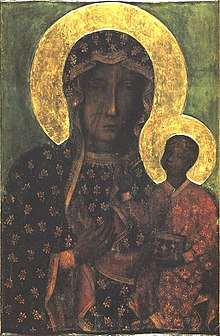Ezili Dantor

Ezilí Dantor or Erzulie Dantó is the main loa (or lwa) or senior spirit of the Petro family in Haitian Vodou.
Worship[]
Tuesdays are the days reserved to worship Ezili Dantor, practice which is normally done in solitary by the worshipper in front of an altar identified by the colours blue, green and red. The most recurrent sacrifices consist in samples of créme de cacáo, jewels, specially golden rings and Agua de Florida. For her birthday a wild pig is normally the main sacrifice.[citation needed]
Ezili Dantor and the Haitian Revolution[]
It is accounted that the slave revolt of 1791, started with a pact which followed a big feast in honour to Ezili Dantor. For this reason she is considered the national loa. Considered to be the loa of vengeance and rage, made it to be popular among single mothers during the 1980s and 1990s in Haiti and Dominican Republic.
The syncretic modern representation of this loa is commonly associated to the Black Madonna of Częstochowa,[1][2] the patron saint of Poland. The original association of Ezili Dantor with this Catholic icon is hypothesized to be from copies of the icon brought to Haiti by Polish soldiers sent by order of Napoleon Bonaparte, to subdue the then still ongoing Haitian Revolution. It is accounted that the Polish legion saw the struggle of the Polish nation during the Partitions of Poland in the struggle of the Haitian slaves in fights for their freedom, and as a result the Polish soldiers eventually turned on the French army to join the Haitian slaves.[3] As a consequence of this action, during Jean-Jacques Dessalines's 1804 massacre, which took place short after the Haitian victory; the Poles were left alive and granted citizenship of the newly-founded Republic of Haiti. The descendants of these soldiers are still living in the island, specifically in the locality of Cazale.[4]
A generalized misconception about Ezilí Dantor is to associate the loa with motherhood, mostly in Louisiana's voodoo and other American modern assimilations of voodoo. Mostly because of its association with a portrait of Mother Mary with child Jesus. The accurate modern reading from Haitian accounts by voodoo priests and worshippers from the island, is to associate the pink dressed child Jesus with Ezilí Freda, the younger sibling of Ezilí Dantor, who is also responsible of leaving 2 scars on Dantor's cheek during a fight over the love of Ogun, according to the legend.[5]
References[]
- ^ Smith, Bonnie G., ed. (2008). The Oxford Encyclopedia of Women in World History, Vol. 1. Oxford University Press. p. 436. ISBN 978-0-19-514890-9.
- ^ Krista, White (1999–2000). "Espousing Ezili: Images of a Lwa, Reflections of the Haitian Woman". Journal of Haitian Studies. Center for Black Studies Research. 5/6: 68.
- ^ Abbott, Elizabeth (21 July 2011). Haiti: A Shattered Nation. ISBN 9781468301601. Retrieved 1 January 2015.
- ^ "Re Polish presence in Haiti : Judson comments" Archived 2008-03-25 at the Wayback Machine—Discussion on webster.edu.
- ^ Llerena Cano, Guillermo. The Petro and the Rada. January 2011.
- Folk saints
- Haitian Vodou gods
- Black Madonna of Częstochowa
- National personifications
- Polish diaspora in North America
- Haiti stubs
